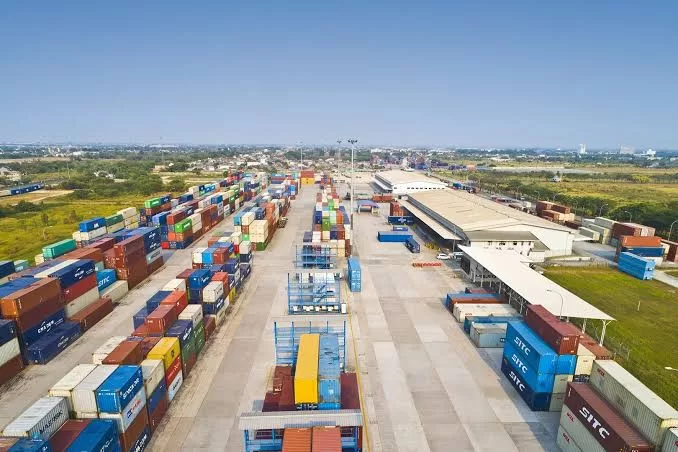Tanzania and the Democratic Republic of Congo (DRC) have just finished the negotiations for the handover of land for the development of Tanzania-DRC Dry Port infrastructure in both countries. This is part of the two country’s broader strategy for the enhancement of regional trade.
According to the Tanzanian government, this move comes after a significant 180 per cent increase in cargo for DRC via the port of Dar es Salaam within the past 4 years. Additionally, the new development clearly indicates the urgent need for supporting infrastructure, especially dry ports.
Project Factsheet
Background:
- This agreement followed a significant 180% increase in cargo destined for the DRC through the Dar es Salaam port in the past four years, highlighting the need for improved infrastructure.
- The total cargo volume at the Dar es Salaam port has doubled in the past four years, rising from 14 million to 28 million tonnes.
Land allocation:
- Tanzania will be allocated land in Kasumbalesa, Kasenga, and Kalemie within the DRC for the development of dry ports.
- The DRC will be granted land in Kwala Coast and Katosho (Kigoma region) in Tanzania for similar development.
- The size of the land secured by Tanzania in the DRC is 60 hectares.
Development model:
- The dry port development project will operate under a public-private partnership (PPP) model.
- Also, private companies will manage a significant portion of the transport system, particularly for the mining sector.
- The governments will oversee other areas.
Project timeline:
- The dry port development project is set to be completed within 18 months from the commencement of construction.
Overall significance:
- Improve cargo transport efficiency between Tanzania and the DRC.
- Reduce congestion at the Dar es Salaam port.
- Streamline transit cargo management.
- Expedite the movement of goods to and from the DRC and other landlocked neighbors like Burundi.
- Strengthen road, railway, water, and air transport infrastructure.
- Contribute to greater economic cooperation and trade efficiency in the region.
- Lastly, it will boost transshipments at Tanzanian ports.
Challenges and considerations:
- Securing financing for the large-scale infrastructure development.
- Ensuring effective coordination between the public and private sectors in the PPP model.
- Addressing any potential logistical or regulatory hurdles that may arise during the development and operational phases.
- The need for complementary investments in connecting infrastructure like roads and railways.
Project Background
In the year 2022, Samia Suluhu and her DRC counterpart signed a Memorandum of Understanding (MOU) for the joint development of transport infrastructure. Furthermore, speaking at the event that was held in Lubumbashi, DRC, on Saturday, April 5, 2025, Ministry of Transport Permanent Secretary, Prof Godius Kahyarara, described the agreement as one big milestone in the implementation of the 2022 bilateral infrastructure development pact.
Details of the Agreement
In this agreement that was signed, Tanzania is set to receive land for dry port development in Kasumbalesa, Kasenga, and Kalemie in DRC. As for DRC, it will be allocated dry port sites in Kwala Coast and Katosho (Kigoma) in Tanzania.
Also read: Tanzania’s Kwala Dry Port Completion Expected to Ease Dar es Salaam’s Lorry Gridlock
This agreement is foreseen to improve trade and enhance transport efficiency through the port of Dar es Salaam.
Construction Period
The dry port project is expected to be completed within the next 18 months. Additionally, it is expected to operate under the Public-Private Partnership (PPP) model.
“As for now DRC is the largest user of the port of Dar es Salaam among Tanzania’s neighbouring countries. As a result of the reforms that were implemented by the 6th phase government, cargo headed for DRC has increased by over 180 per cent,” Prof Kahyarara mentioned in a statement.
Also read: Construction of Congo’s Deep-Sea Port: First of its Kind
“The surge has made it necessary for the development of infrastructure, including dry ports both within and outside our country,” he also mentioned.
What Called for the Need of the Project?
He also noted that total cargo at the port has doubled from 14 million to 28 million tonnes within the past four years. This has therefore called for the need for expansion of the port infrastructure.
Furthermore, he also noted that the strategy of the government also entails increasing the overall number of berths and also expand ports in Kalemie (DRC), Kigoma, and Kalemie (Tanzania).
Tanzania and DRC are part of the Central Corridor. This is a regional trade route that connects seven countries. Lastly, the key objective is to enhance road, railway, water, and air transport infrastructure.
Also read: Tanzania’s Dry Port in Dodoma Takes Shape as TPA Acquires 490 Hectares for Its Development

